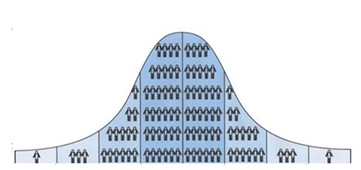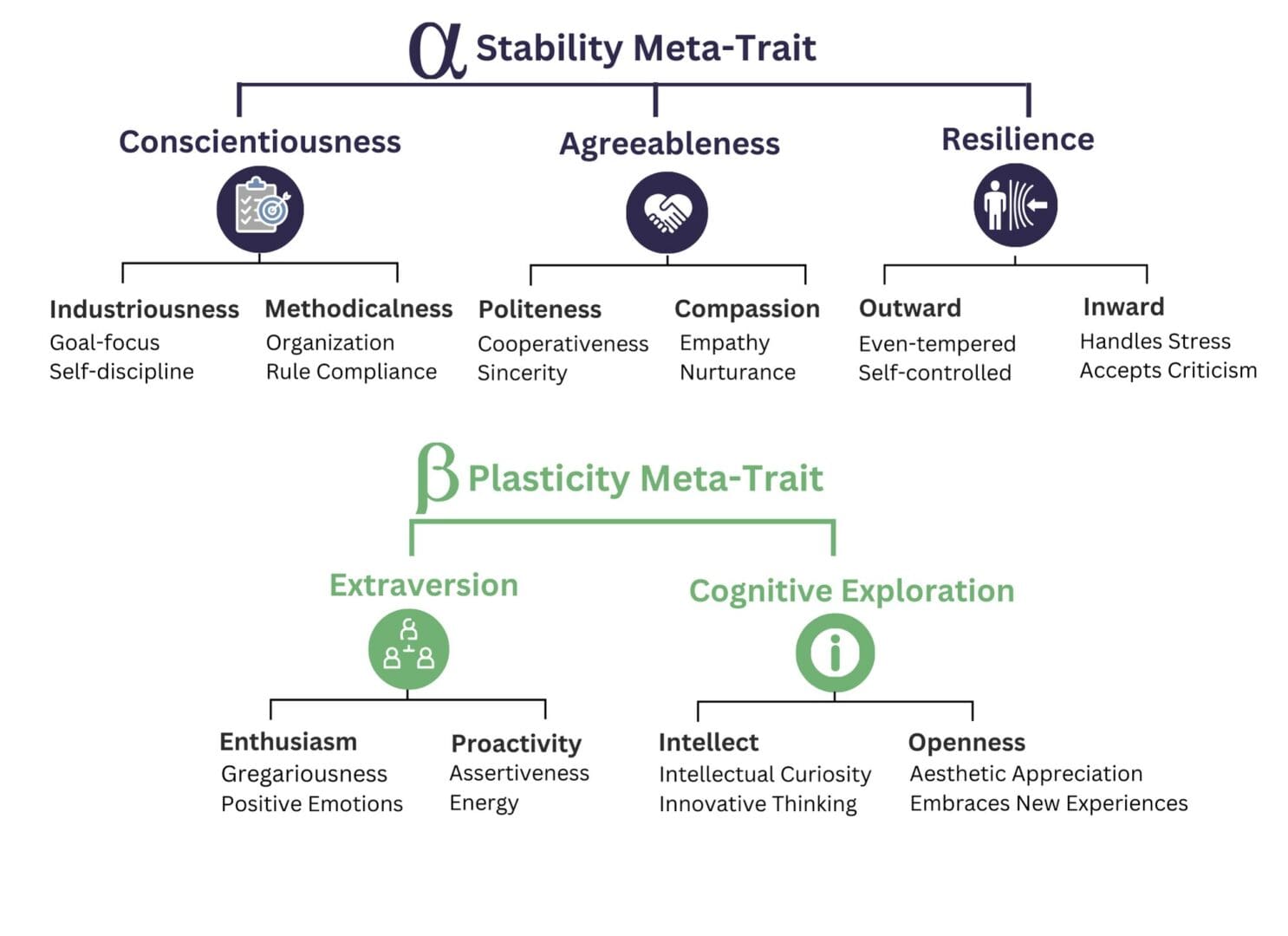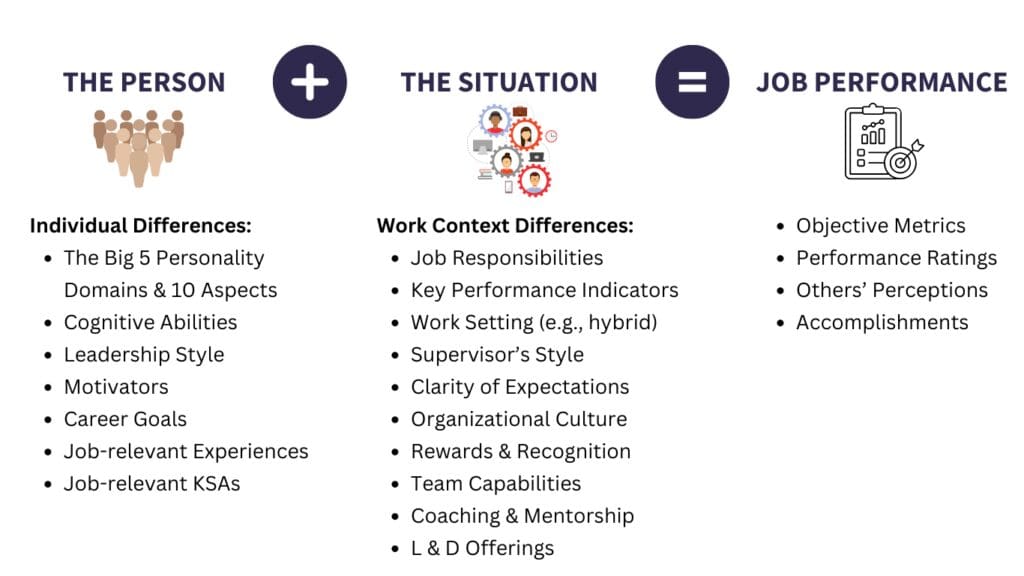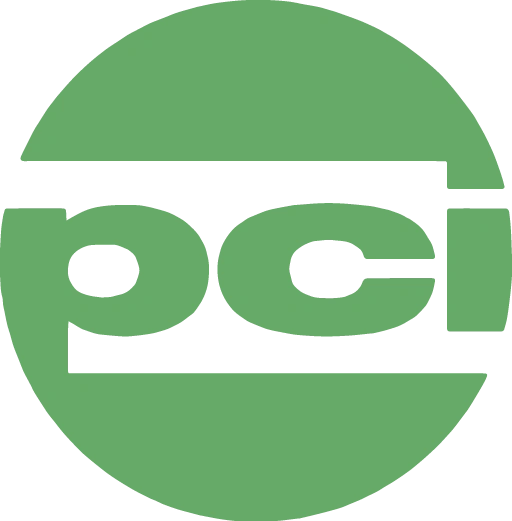Personality Assessments in the Workplace
Should personality assessments be used in the workplace?
The short answer is, “Absolutely!” There is an overwhelming amount of scientific research showing that personality predicts just about any outcome of interest to an organization. The below chart shows some of the many things you can predict by using personality assessments in the workplace. If you care about any of these outcomes, keep reading!
Some Work-related Outcomes that Personality Predicts

*OCBs are Organizational Citizenship Behaviors and CWBs are Counterproductive Work Behaviors.
What is Personality?
Personality is defined as the enduring thoughts, feelings, actions, and motivations that influence an individual’s unique adjustment to life.
Personality Traits (versus Personality States)
Traits versus States can be thought of like Climate versus Weather:
- Personality traits are the overall patterns that appear over a long period of time. (i.e., the climate where you live).
- Personality states are the thoughts, feelings, and actions a person has in a specific moment or situation (i.e., today’s weather where you live).
- The difference between the two can be big. For example, someone who is usually outgoing (trait) might still act shy in certain situations (state). Or someone who is usually optimistic (trait) might feel down during a negative life event (state).
- Personality traits are more useful for predicting long-term outcomes than states. Just like it’s better to consider the climate of a place, rather than the weather on one particular day when deciding where to live.
As you can see from the short definition above, personality is complex because it’s comprised of 4 different characteristics (thoughts, feelings, actions, and motivations). In fact, the American Psychological Association’s long-version definition states that it is a complex, dynamic integration or totality shaped by many forces.
So, it takes specialized education and years of experience to predict on-the-job behavior based on personality. In this article, we’ve boiled the complex science of personality down to a few key points to help you make good decisions related to personality assessments in the workplace.
Employee Personality Tests should measure Personality Traits, not States.
What tools should be used to assess personality traits?
A self-report personality test is the most effective and efficient way to measure Personality Traits. This method is better than having other people rate someone’s personality. There are two reasons for this.
- Personality traits include thoughts, feelings, and motivations, which are not easily observable by others.
- The individual knows a lot more about how they behave in a variety of situations, including when no one is watching. In general, people know themselves a lot better than others do.
There are many different self-report personality tests. In the next sections, you’ll learn the differences between those that add value in the workplace and those that don’t.
What are the Worst Tests for Assessing Personality Traits?
One of the worst ways of assessing personality in the workplace is to use any type-based indicator like the MBTI, DiSC, or Enneagram. Why? A few of the reasons are explained below.
- These models were created based on personality theories that are not backed by solid evidence.
- There is little evidence on the reliability and validity of the most popular personality type-indicator tests. That’s why even the publisher states that the MBTI SHOULD NOT BE USED TO MAKE EMPLOYMENT DECISIONS.
- These tests wrongly categorize people into strict personality types. Personality traits don’t fit neatly into boxes, they exist on a scale. This is explained in more detail below.
Most people have an average amount of a personality trait. Fewer people are at the tail ends of the below bell-shaped curve (very little or a lot of the trait). So, instead of being one type or another, people have different levels of a trait, falling anywhere along the continuum.

Height and shoe size are two examples of things that are measured on a continuum and represented in the population in a bell-shaped curve, just like personality traits. Now, imagine if we didn’t use measurements like inches or centimeters. People would just be labeled as Tall or Short and their feet Small or Large. Imagine how difficult clothes and shoes shopping would be! If that sounds absurd, then so should labeling someone as simply an Extrovert or an Introvert. Categorizing people this way is unhelpful and severely limits the information needed to understand or predict their behavior.
Would you hire someone based on their zodiac sign?
While you might believe that using horoscopes or phrenology to assess personality would be worse than a Type Indicator, at least most people don’t take these methods seriously.
On the other hand, the MBTI is one of, if not the, most popular measure of personality. Along with the DiSC, it is used extensively in the workplace for all purposes. The worst thing about these tests is that they give the illusion of being scientific but are pseudoscientific.
If the results seem accurate to people who take them, it’s mainly due to a phenomenon called the Barnum Effect. This is when vague statements seem personally relevant, although they actually apply to everyone.
What are the Best Tests for Assessing Personality Traits?
Employee personality tests should meet two criteria:
1. It Measures the Five-Factor Model of Personality (FFM, a.k.a. The Big Five). Here’s why:
- It’s based on science and was developed using a method called Factor Analysis.
- The model is the same across the globe.
- Over 40 years of research has proven the FFM’s ability to predict work-related outcomes.
- The FFM is the most widely accepted personality model among experts.
2. It’s psychometrically sound.
- This means it’s backed by rigorous statistical research and shown to be reliable and valid. So, you can’t use a free version you find online.
- Before purchasing a personality test for hiring or development, ask to see the technical manual and have it reviewed by an Industrial/Organizational practitioner.
What exactly does a Big 5 personality test measure?
Using personality assessments in the workplace to predict performance is not a simple task. That’s because the structure of personality is complex. Here’s what you need to know about the research:
- Personality is organized in a hierarchy, starting with broad categories (Meta-traits) and getting narrower and more specific as you go down (Domains, Aspects, and Facets).
- The Big 5 are the second level from the top in the hierarchy. The Big 5 are called Domains and they are located beneath each of the Meta-traits in the below graphic. Each Domain has 2 Aspects. Each Aspect has several Facets, although we only included 2 in the graphic to simplify it.

- The most useful Big 5 personality tests give you Meta-trait, Domain, Aspect, and Facet scores. That’s because each predicts different things.
- The 25+ Facets of personality interact with each other to make each person as unique as snowflakes. That’s why people can’t be categorized into a type.
Personality is Complex. It can’t be simplified into Types.
The Art of Interpreting Personality Surveys
In addition to the science behind the surveys, there is an art to using personality assessments in the workplace. For high-volume roles, an off-the-shelf test with an automated report may be a good option to help you screen out candidates who do not have minimally acceptable traits and abilities. However, for professional through executive roles, it’s not a good idea to make talent decisions based on your interpretation of an automated personality test. Below are some reasons why.
Personality Tests don’t capture the whole person.
It’s important to supplement a personality survey with other evaluation tools. The most common one is an in-depth, structured interview. This should include job fit, past behavior, and situational items. Check out our article on leadership assessments for more information on structured interviews and other evaluation methods that help you capture the whole person.
Job performance is a combination of what’s inside the person and the situation.
Generally, the stronger a situation is at work, the less impact personality will have on their behavior at work. However, it’s rare for a situation to completely negate the effect of someone’s personality. Because both are important, you should also evaluate the situation the person will be in if hired, promoted, or moved into a new role.

Personality Assessments are Based on Probability, not Certainty.
Even though personality traits can strongly predict how someone is likely to perform at work, the predictions aren’t perfect. There will always be times when someone does better or worse than expected. Often, this is because the situation influenced the outcome a lot. For instance, the organizational culture might bring out the best in the person. Or, a very talented person ends up with a supervisor whose style brings out the worst in them.
- Don’t over-focus on job experience in a different company. It tends to be a weak predictor of how someone will perform in a new company because nearly all situational factors are different.
- By assessing personality in the hiring process, it helps you figure out how much of someone’s success comes from who they are versus the situations they were in.
- We’ve said it earlier, but it’s worth saying again. Because no single tool perfectly predicts performance, use multiple methods of evaluation when making talent decisions.
Personality Test Interpretation Requires Expertise
Because assessing personality is so complex, it should be done by a business psychologist who understands how personality works. Here’s what a subject-matter expert knows and does:
- Deep knowledge of the latest research on which personality traits are best at predicting different work behaviors and outcomes.
- Many years of practical experience interpreting thousands of personality survey results in work settings.
- Combines information from a personality survey with results from other tools for a whole person assessment.
- Interprets the results within the context of the job the person is being considered for. Explains what combinations of traits are likely to influence a person’s ability to perform the job responsibilities successfully.
- Write a report that tells a clear and compelling story of how a person is likely to behave at work and what (if anything) you can do to help them improve and succeed.
- Serves as an advisor. Supplementing reports with a debrief allows decision-makers to ask questions and gain more insights into fit for role and advancement potential.
Most people don’t make medical decisions based only on lab results without consulting a doctor. Likewise, you shouldn’t make employment decisions based on personality test results without talking to a subject matter expert.
What Talent Processes are Personality Assessments Used For?
Personality Assessments for Hiring & Placement Decisions
Assessing personality using a reliable personality survey based on the Big Five/Five-Factor Model should be a key part of any well-designed pre-employment assessment. A few key points:
- While a person’s personality can change, it tends to stay pretty stable once they become an adult. Significant changes usually take a major life event or a lot of time and effort. That’s why it’s important to assess someone’s personality and other traits BEFORE hiring them. Not everything can be developed, and even if it can, it might take more time and resources than you have.
- Assessing personality is also helpful when considering a current employee for a promotion. Since a higher-level job involves a new situation that’s more complex and demanding, you need to know if the person has what’s needed to succeed. If they don’t, it can help identify areas where you can focus on developing them.
Using Personality Tests for Development
Most people enjoy taking personality tests because they help them better understand themselves. Here are a few best practices to help you use personality assessments effectively to develop talent:
- Give employees personalized versus automated reports. This will enhance their buy-in to the results since it’s not canned content.
- The report should directly state their likely strengths and areas for improvement. Telling people that all styles have benefits is not helpful for growth. People need to know what aspects of their personality may be holding them back so they can intentionally learn behaviors that will help them succeed.
- The employee and their manager should use the results as input into a written development plan. The plan should include strengths to leverage and gaps to fill.
- Their manager should also use the personality assessment information to proactively monitor and address the person’s gaps and make the most of their strengths.
The Role of Personality Assessments in Succession Planning
Succession planning requires a robust assessment of advancement potential. While cognitive ability is a strong predictor of advancement potential, personality also plays a role. So, your succession planning process should include a Big 5 personality assessment in addition to intellectual aptitude tests.
Accelerate Coaching with Personality Assessments
Assessing personality gives the coach and coachee insights into the Why behind the behaviors they want to change or develop through the coaching engagement. One of our clients once told us that the personality assessment report we delivered saved her 6 months of getting to know her coaching client!
Key Takeaways
- When using personality assessments in the workplace, make sure it’s a well-researched, reliable, and valid measure of the Five-Factor Model of personality (NOT type-indicators such as the MBTI or DiSC).
- Personality assessments are appropriate for all talent processes, including your hiring (external and internal candidates), development, coaching, and succession planning processes.
- For the best talent decisions, personality assessments should be combined with other tools (e.g., structured interviews, cognitive ability tests that match the job’s level of complexity, and a leadership style survey for supervisors, managers, and executives.)
- Personality assessments will be most predictive of job performance and on-the-job behavior when they are interpreted by an experienced business psychologist with subject-matter expertise.
Learn more about how to properly use personality assessments in the workplace.
Contact Keith Francoeur
Vice President of Assessments
kfrancoeur@pciassess.com

